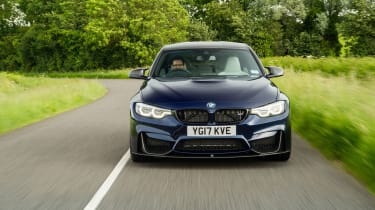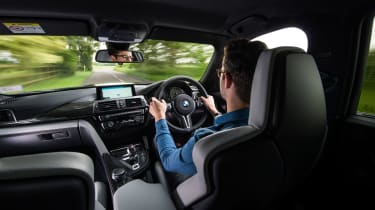F80 BMW M3 review (2014-2018) - ride and handling
The latest updates to this performance car icon have improved it greatly, it now has the composure to match its mighty performance
It’s no secret that there were elements about the way early F80 M3s drove that have left us less than impressed. Our issue mostly stemmed from the body control at the rear axle; bumps and crests created a disproportionate amount of movement that took time, and a smooth road, to settle. The unruly rear axle combined with the M3’s vast torque and its snappy DCT gear changes meant that the F80 was tricky car to stay on top of on a demanding road.
However, facelifted 2018 model-year cars are vastly improved. Even at low speeds the M3 feels more settled than its immediate predecessors, and it remains calm and poised as the speed builds.
One aspect of the M3 that has never been in doubt is just how impressive the front axle is. There is truly fantastic grip on turn in, meaning you can carry huge speed into a corner without any understeer. The steering doesn’t transmit much usable information about what’s happening between the tyres and the road but, with such a dependable nose, you can be incredibly accurate when placing the car. What’s more, this generation of M3 now has a set of brakes up to the task of stopping a powerful saloon car so, whether they’re the standard steel brakes or optional carbon ceramics, you can really lean on them.
To no one's surprise, the M3’s huge power and torque mean that rear traction can often be limited, especially in the wet. But, although you can’t always use full throttle on the exit of every corner, the massive performance allows you an extra way to control and manipulate the M3 in a corner: via the throttle. An extra squeeze of the accelerator immediately makes the car rotate, and with a touch of corrective lock the front end keeps you pointing in the right direction.
More reviews
Group tests
In-depth reviews
Review
Reviews
Even once rear traction has been lost, and the wheels have started to spin, the M3 builds speed in a remarkable way. Even when you expect forward progress to be wasted in a cloud of tyre smoke a squeals, the M3 continues to thrust forward.
The M3 isn’t playful enough with the traction control fully on to allow such behaviour. Switch it to its semi-off state, MDM, and you are able to get a taste of this extra adjustability. Although this safety net does stop things getting out of hand – incredibly useful when the roads are wet and cold – it’s still very restricting.
M3s fitted with the Competition Package are not only more powerful, but chassis changes improve the body control at the rear even further to suit the extra grunt.
On track the M3’s mighty front end and masses of torque mean that it’s all about managing oversteer. Every prod of the throttle, even through some of the faster corners has the rear tyres spinning. But, thanks to a very transparent limited slip differential, that locks early and remains consistent throughout a corner, it feels very natural to drive at the limit. The engine’s response means that once you’re accustomed to the M3’s balance, you can restrict the slides to small angles and refrain from losing too much speed to wheelspin.
Of course, such attributes make the M3 the consummate hooligan on track, too. The motor’s spiky turbocharged torque delivery means that you can very easily apply too much throttle to initiate a slide, then you have to be very quick with the steering to catch it. But, set to its firmest mode, the chassis keeps the body controlled and drifts are just as easy to gather up as they are to start.





